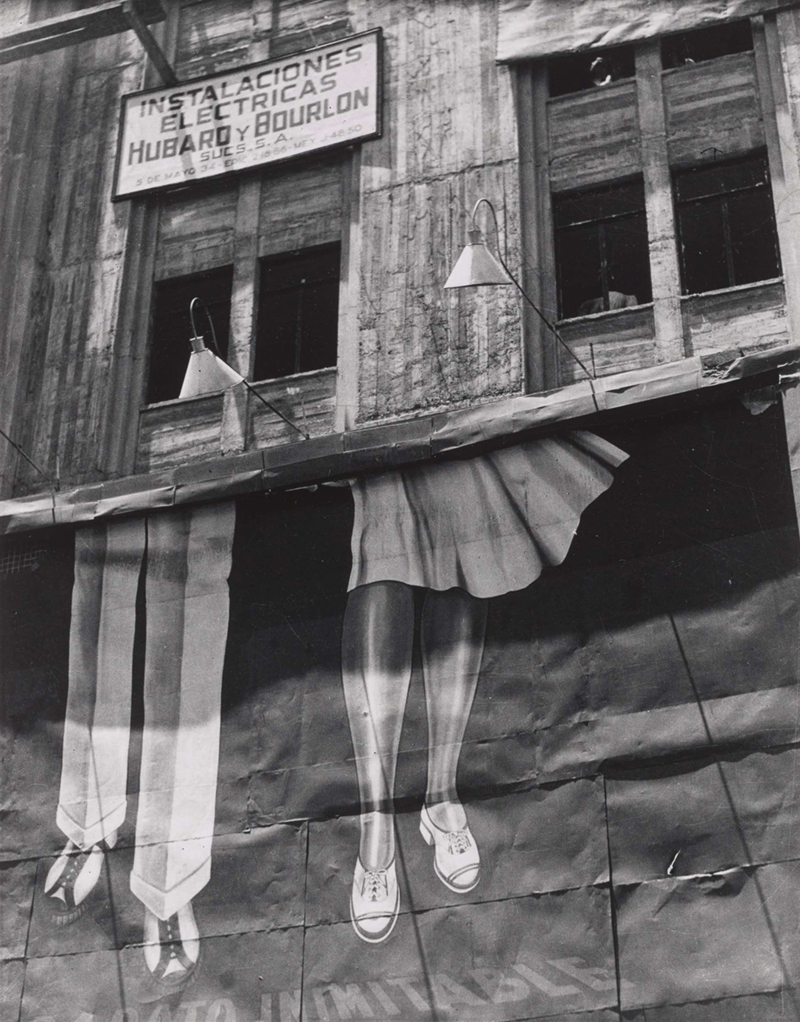January Object of the Month: “Dos Pares de Piernas (Two Pairs of Legs)” by Manuel Álvarez Bravo

Dos Pares de Piernas (Two Pairs of Legs), 1928–1929, gelatin silver print, by Manuel Álvarez Bravo, Mexican, 1902–2002. Gift of Michael G. Frieze, Class of 1960. Bowdoin College Museum of Art
A peeling, painted billboard advertises high street fashions—crisply creased trousers, pleated skirts, and fashionable footwear—to the upwardly mobile, attesting to the emergence of consumerism. The text of the advertisement, “Barato Inimitable” (“Cheap and Unbeatable”), reveals the forces of industrialization and globalization driving the availability of consumer goods. Above, the electrician’s signage hints at the labor and technology behind Mexico’s modernization. The many facets of Mexican modernity are juxtaposed in this enigmatic image, taken in the late 1920s in Mexico City. Yet, like so much of Manuel Álvarez Bravo’s work, this image is pervaded by an air of mystery, both revealing the subtle textures and rhythms of daily life and probing the unseen. Here, the disembodied legs in stride seem to symbolize a society on the move. But who are they, and where are they going?
Manuel Álvarez Bravo (1902–2002), Mexico’s most well-known photographer, is celebrated today as a giant of twentieth century photography. His long career—he was active into his 80s—spanned critical years in the evolution of Mexican culture, an era when Mexicans actively redefined their collective identity and reckoned with forces of modernism and colonialism. Coming of age during the Mexican Revolution and launching his career in its wake, Álvarez Bravo witnessed firsthand the power of art to inspire change and to revitalize traditions. Throughout his long career, he depicted his changing country with sensitive lyricism and rich symbolism. His camera captured the culture, people, and landscape of his native land, from scenes of Mexican countryside to the shop windows of Mexico City, religious rituals to modern industry, and intimate moments of everyday life. While his work is deeply rooted in his country, his photographs eschew realism for a poetic vision, signifying deeper meanings through symbol and metaphor. His often-mystical images prompted fellow photographer André Breton, who met Álvarez Bravo on a visit to Mexico in 1938 and championed his work in Europe, to dub him a “natural surrealist.”
This photograph is one of several by Álvarez Bravo that appear in the exhibition Pasado y Presente: Twentieth-Century Photographs of a Changing Mexico alongside works by Manuel Carrillo, Kati Horna, Dana Salvo, Marilyn Bridges and Ken Heyman. On view January 7 through March 15, 2020, the exhibition is curated by the students in the fall course “War of the Latin American Worlds” and Carolyn Wolfenzon Niego. Over the fall semester, the students engaged with works in the Museum collection, drawing connections between the work of photographers like Álvarez Bravo and the Mexican literature they were encountering in class in order to share their insights about modern Mexico. In the exhibition, the students have paired photographs with quotes drawn from class readings, further revealing the ways that artists and authors alike reinvented Mexican identity—and Mexico—over the twentieth century.
Carolyn Wolfenzon Niego, Associate Professor of Romance Languages and Literatureand
Sean P. Burrus, Andrew W. Mellon Post-Doctoral Curatorial Fellow